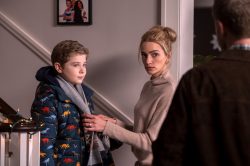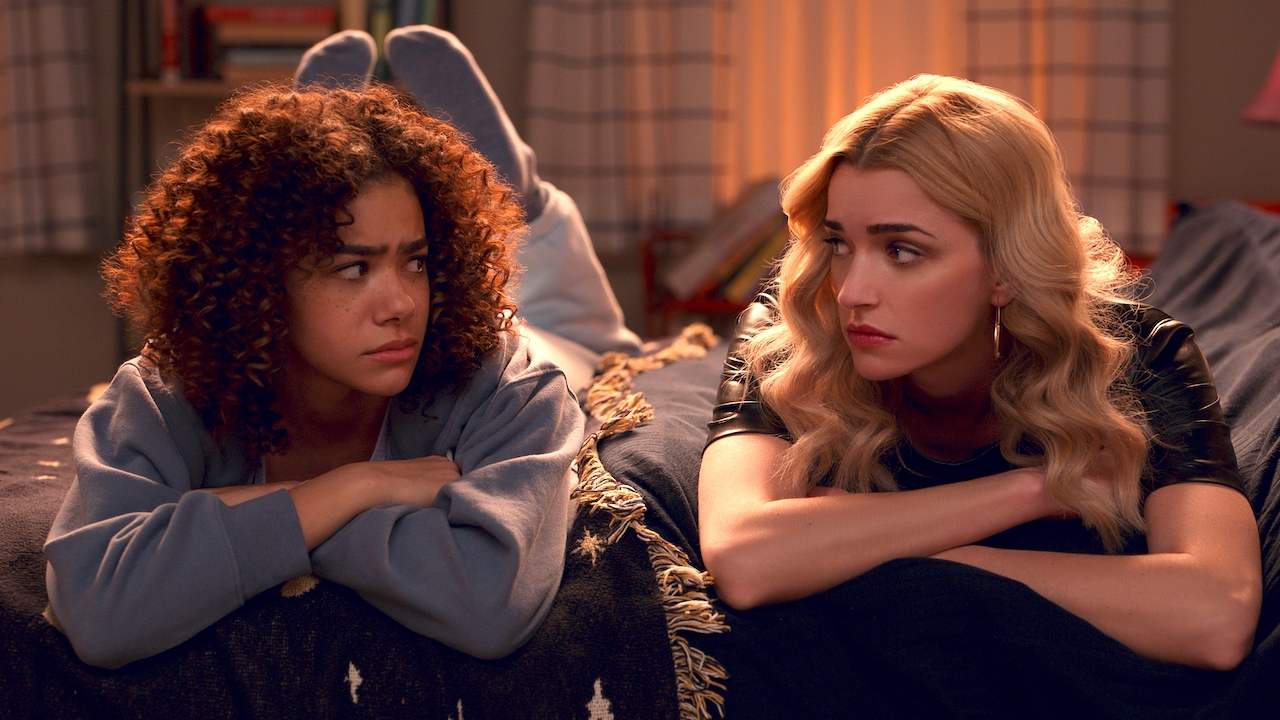Wellsbury, Massachusetts will never be the same. Georgia Miller (Brianne Howey), her daughter Ginny (Antonia Gentry), and her son Austin (Diesel La Torraca) may have finally found stability, acceptance and familial happiness to counter their constant fight or flight instincts.
Sarah Lampert, who created the show spoke with Creative Screenwriting Magazine about her peculiar mix of mystery, intrigue and suspense laced with modern, soapy, coming-of-age storytelling. “Ginny & Georgia needs to be entertaining. We want people to care about the characters and take them on a wild ride.” It’s essential that the audience connects with the characters since the tone and energy of the show bounces around throughout its ten-episode season. “We gave ourselves permission to be messy as soon as gave the characters permission to be messy,” declared Lampert unapologetically. Despite the wild, fun ride of teenage angst, Ginny & Georgia does visit some dark and serious spaces with due attention.
We create humor in the face of darkness
“I wrote the pilot during a class I was taking because I was frustrated with myself for not writing enough to spur myself with some solid deadlines.” Lampert had gone through a devastating break up, the pieces of which laid the emotional groundwork for the show. “I wanted something productive to come out of what I was feeling. It’s an amalgamation of shows that matter to me.” The coming of age audience was the one she wanted to speak to. And so she did.

Sarah Lampert
Sarah Lampert declined to contain Ginny & Georgia into a single genre convention. Not because she didn’t know, but because it doesn’t serve the show to a great extent. Is it a comedy or a drama? After much deliberation, Lampert paraphrased a review of the show to respond, “It’s Guy Fieri’s Trash Can Nachos and I’m a hungry racoon.” Eat fast before they’re all gone and don’t get heartburn. But still no genre definition. “It’s a messy combination of both,” she finally confirmed. Lambert’s goal is to invite the audience into the wonderful world of Wellsbury and its colorful inhabitants.
“The show is every genre. We don’t try to be one thing too hard.” This controlled chaos was born from the freedom and creativity of the show. The characters are the nucleus and the genre are the satellites which may briefly enter its orbit.
“No idea is off limits. We don’t take ourselves too seriously although we handle serious subjects with absolute care.” The show’s writing team partnered with Mental Health America and has a licensed therapist on call to read the scripts for an accurate depiction of issues like self-harm and depressive episodes.
Ginny & Georgia pivots between these two main characters with regard to narrative point-of-view. When we asked Lampert who the main character was, she replied, “The relationship between the two characters. That’s the ever evolving main character.” In the writers’ room, they plotted Ginny and Georgia’s arcs on one board and their relationship arc on a third board. At times the room was serious and intense, while others it was very playful.
The season was plotted with a definite ending mind. The middle was invented along the way. “There was a lot of free space for how we got there. There was a lot of creation.” Sarah earmarked the main tentpole moments for the season and the writers’ room not only creatively filled in the gaps, but at times, changed the course.
Certain unlikely character pairings were also explored in the writers’ room such as the Ginny and Marcus and Marcus and Hunter Chen (Mason Temple) relationships.
Ginny and Georgia are best friends and worsts enemies as illustrated by their actions. “They have a deep love for one another, but neither can fully understand the other’s world experiences.” They navigate the world with a deep propensity to hurt each other despite their love for each other.
Austin Miller may occupy less screen time than Ginny & Georgia, but nonetheless, he’s pivotal in influencing the Millar family dynamics. “He’s the third leg in the family. Austin also grapples with things Georgia’s done just like his sister.”
Georgia wears a thickly-layered Southern charm which contrasts nicely with the highly buttoned up New England demeanor. “Fry-yay was such a ‘Georgia Miller’ thing to do so we added it to the show,” joked Lampert who grew up in Massachusetts not the South. Frying everything edible in sight on the day after Thanksgiving was not included simply for comical effect. “We wanted a fish out of water feeling for Georgia when she moved to Upper-Crust New England from the South.”
Who Is Georgia Miller?
It would be an understatement to label her as either a villain or heroine, good or bad. That would be a judgment reserved for the audience because she transcends such a simplistic dichotomy. She’s a survivor who makes conscious choices to protect her children. Although her choices may sometimes be morally dubious, “It’s us against the world.”
“Does she do bad things?” asks Sarah. “Absolutely.”
Georgia may or may not have killed someone or someones, but then again, nobody’s perfect. “That’s just part of who she is. She’s a very complicated, very messy anti-hero which makes it hard to root for her at times.” Yet she has enough goodness and charm to keep the audience interested.

Austin Miller (Diesel La Torraca) & Georgia Miller (Brianne Howey) Photo by Amanda Matlovich/ Netflix
This character complexity is Sarah Lampert’s hallmark. “My favourite thing to do is take characters you think you know and surprise us and complicate their relationships to us and each other. I’m not interested in characters who are always right or always wrong. One of the key themes of the show is it’s hard to human. Their flaws give them room to grow. Nobody likes perfect characters.”
Voiceovers and Flashbacks
The show makes effective use of flashbacks and voiceovers in compressing the Ginny’s past and present.
Much of what Georgia experiences today is rooted in her past life experiences. Ginny & Georgia frequently and strategically yanks the audience back in time to a younger Georgia and younger Ginny to show their everyday struggles.
Sarah Lampert also uses plentiful voiceover, “so we enter their worlds inside their heads.” Much of Georgia’s actions are off-screen, but the repercussions are on-screen. “We get more insight into them, what they’ve been through, and what they’ve come out of.” The younger versions of these characters fill in the spaces of their older versions. “They’re working in tandem to tell that story.”
Flashbacks are such an instrumental component of Lampert’s storytelling machinery, that a special board is dedicated to them in the writers’ room. They have their own progressive arcs.
Ginny’s boyfriend Marcus Baker (Felix Mallard) also makes substantial use of voiceover, especially during his depressive episodes. It is only through voiceover that he can articulate what he can’t express verbally. We gave him a voice when he didn’t have one. Lampert found a special connection to this character in light of the struggles she’s had with depression.
The uneven, and sometimes, choppy mood and pacing of Ginny & Georgia is quite deliberate. “I’m a little bit of a chaos demon, so I rely on the writers’ room to smooth the edges and put up guard rails.” It’s a case of groupthink to beat the malleable tone of the show according to what each writer thinks is going to work the best for the characters. “The actors also weigh in a lot. They are the guardians of their characters. No creative decision is ever made lightly.” The showrunners keep an aerial view of the show and the actors discover the overlooked moments where the characters slip.
The voice and dialogue of the show are distinct for each character. The title of each episode is a line of dialogue from it. Sarah Lampert runs the show’s Instagram account and regularly posts lines of dialogue from unscreened episodes and asks people to name the character most likely to deliver them. They responded with amazing accuracy.
We asked Sarah Lampert which character was most like her in the show. If you answered Ginny or Georgia, you’d be incorrect. “Maxine Baker [Sara Weisglass],” she responded without a second thought. Maxine is Marcus’ lesbian twin sister and drama queen who heavily leans on her friends for advice as much as she gives it. She’s an intense person juggling two love interests and finding herself.
